When it comes to body shop layout and design,
most shop owners would kill – or at least maim – to get their
hands on that one, perfect setup.
It’s probably a good thing, then, that there
isn’t one.
Though some shop owners think there’s "one
perfect plan," what works best for you may not work so well
for Billy Bob down the street. Good, workable layouts depend on
your location, facility, the type of work you do, etc. Definitely
no cookie cutters here.
Though no "best" shop layout is
the same, there are some general rules to follow (see "Blueprint
Boo-boos" on page 46), and learning from what others have
done is the best way to start your layout-and-design wheels turning.
See what you can come up with for your shop after being let in
on how three owners remodeled to optimize their operations.
Schmidt’s Auto Body, Fresno, Calif.
In 1992, owner Dennis Schmidt constructed
an additional, 5,000-square-foot building (a twin to the original)
about 50 feet from his existing building – in which the shop had
done business since 1964.
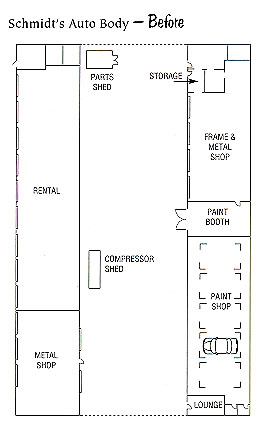
In 1996, Schmidt decided to redesign. Before
getting started, he retained some professional help, based on
a recommendation by his paint manufacturer. Besides recommending
this outside help, his manufacturer also offered two suggestions:
Schmidt needed to move the noise of the body shop away from the
front office and to create more working area due to increasing
business volume.
Following the redesigning and remodeling advice,
Schmidt’s gained improved office efficiency and a more professional,
comfortable office area – which is important for an I-CAR Gold
Class shop to have.
The office, located in the original facility,
is now more up to date. According to Schmidt, the office had three
desks (ones built in the ’40s) and was very outdated. Now, instead
of desks, the office area has modern workstations, an updated
phone system and an additional office. Previously, open space
and two restrooms occupied the area behind the original office,
so by extending the office area farther back, the new office gained
a restroom – a big plus for customers and insurance adjusters.
Another plus for adjusters are the workstations.
The office area still isn’t very large, but
the redesign gave employees much more space in a very limited
area (it’s large enough now to accommodate a complete staff).
According to Schmidt, the biggest benefit of the redesign of the
office area is that it created a much cleaner and more comfortable
space in which to work. Customers have commented on the change:
"They feel like they’re walking into a more professional
office than just what the typical body shop of yesterday looked
like," Schmidt says.
Because of the redesign, customers have at
least three things they didn’t have before: a waiting room, a
unisex office restroom, and some peace and quiet.
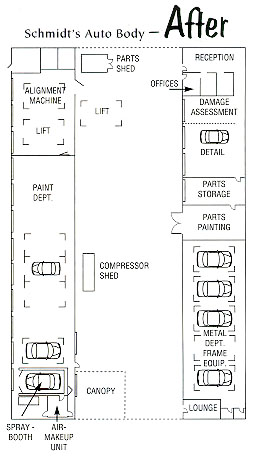
The peace and quiet was obtained by moving
the body shop from the front half of the production area, which
is near the front office, to the rear of the production area.
Now, detail work, pinstriping, headlight aligning, light reassembly
work and A/C recharging are done near the office – also good in
that it keeps the finished product close to Schmidt. "If
I see any defects or problems," he says, "I can send
it back to the body shop or paint shop for corrections."
Moving the body shop – to where the paint
shop used to be – also allowed more working area for the metal
and frame departments because it went from 2,000 square feet to
3,000 square feet; the paint shop was then moved into the new
building. Moving the frame and body shop to the far end of the
building made it possible to have three stalls, each with a frame
rack beside it. Now, each technician and his helper can work on
one car; and after the frame is straightened, they’re able to
bring the car down and put another one up. The additional space
made it possible for Schmidt to acquire a third, much-needed frame
rack.
The paint department also grew from 3,000
square feet to 5,000 (not counting the outside overhang, which
gives the building an extra 2,000 square feet on each side and
is used to prep vehicles or put on moldings, etc.)
Besides purchasing a new frame rack, Schmidt
installed a new downdraft spraybooth, a four-wheel alignment rack,
and an A/C R12 and R134a recharging system. Schmidt’s original
paint booth is still located near the center of the original production
area and is used primarily for jamming parts.
A year and a half and about $175,000 after
the project began, Schmidt says his employees now have the room
they need to be more efficient, and work flow has greatly increased.
"We feel our decision to have a facelift has been a very
worthwhile venture," he says. "Profits are up, along
with productivity. Our employees are happier and take pride in
their repair work with the new space and equipment."
Porter Chevy City, Newark, Del.
Due to the sheer volume of work it’s been
receiving, this body shop is currently expanding to expedite the
flow of work through production, therefore ensuring customer satisfaction.
Body shop manager Charlie Smith says an overabundance
of work due to multiple direct-repair and select-repair programs,
as well as a reputation for quality repairs, left him with no
choice but to expand; he has to in order to satisfy the shop’s
clients. To accomplish this, Smith chose a professional design
based on the advice of his paint manufacturer.
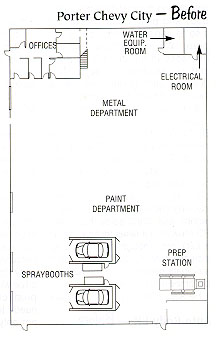
The expansion, which dealer owner Cory Porter
has been very supportive of, is coming along very quickly: The
structure is already built and connected to the present shop,
and it’s expected to be completed mid-month.
"We expect exciting by-products from
this expansion," says Smith, "such as the ability to
perform "express repairs" and, as a direct result of
that, a decrease in car-rental costs to both vehicle owners and
insurance companies. Smith explains that a four-day repair usually
runs over into five or six days. With the new facility, Smith
hopes to reach the goal of meeting repair times allowed by insurance
company estimates. He also hopes to make more money by being able
to repair more cars.
The expansion has doubled the shop’s size
– from 15,000 square feet to 30,000 square feet. And by adding
a two-story addition to the shop, Smith was not only able to completely
separate the body and paint departments, but also to separate
paint from paint prep. "We anticipate a dramatic decrease
in the need for buffing and wet sanding," he says. "This
dust-free paint environment will be the first of its kind in our
area."
Smith estimates the shop’s final outpay for
the project to be $600,000, but he also anticipates this investment
to pay for itself within five years. The expansion hasn’t yet
affected production, but Smith plans on measuring the increase
in productivity on a weekly and monthly basis by tracking productive
hours of technicians, parts sales, hours per RO (how long it takes
techs to repair a car), etc. Though he expects an increase in
production, Smith doesn’t anticipate seeing it until the addition
becomes fully operable.
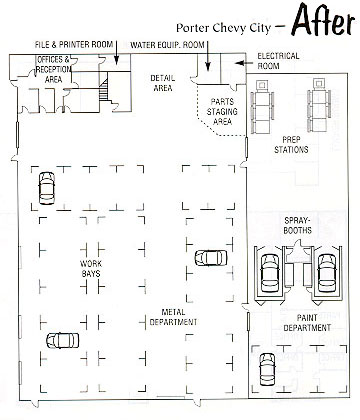
He also anticipates some production challenges
when the time comes to relocate the paint booths. "The important
thing is to plan for production challenges," says Smith.
"Have meetings with your staff prior to any anticipated problems
or delays. Let your office and shop staff be aware of probable
side effects the expansion may have both during and after completion."
One side effect for Porter Chevy will occur
when Smith extends the hours of operation as it becomes necessary,
which will include Saturday hours and two shifts. He also plans
to expand and redesign the shop’s office, taking it from 1,200
square feet to 2,400 square feet. "When planning an expansion
or redesign, don’t forget about your administrative facility and
personnel," says Smith. "A smooth, easy-flow design
and staff in your office will be echoed by a free-flowing production
staff. Your office also needs to be able to accommodate not only
additional staff members necessary to support your increased volume,
but also higher traffic of adjusters, reinspectors and customers
waiting for estimates."
Smith also offers this advice to any shop
owner considering expansion and/or redesign:
- Fools rush in. Make sure you have consistent volume
over a two- to three-year period. - Max out your existing facility before considering alterations.
- Get help. Don’t try to design your facility on your own; call
professional layout and design planning companies to do a facility
evaluation and a market-share survey before you commit to alterations.
Auto Body, E.R., Akron, Ohio
An investment banker, Auto Body, E.R. President Mathew Hanson
found himself wanting to enter the collision repair industry and,
in doing so, wound up having to transform a former track and racquetball
club into a body shop.
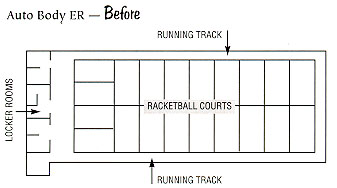
Hanson first encountered the collision repair industry while assisting
FinishMaster, Inc. – a paint, body and equipment supplier (PBE)
– in making 33 acquisitions of smaller PBE operators. As a result
of this experience, Hanson got the urge to enter the industry
and then spent 18 months researching it – with the intention of
making acquisitions of existing collision repair businesses. While
unsuccessful in buying a facility, he remained committed to becoming
an industry player and decided to enter the industry on a start-up
basis. After researching the market for several months, Hanson
located the racquetball-club facility, which was in an area that
had a need for an independent repair facility.
Hanson’s entire building is about 29,000 square feet, including
a mezzanine area. The entrance had a front-counter area, a couple
of offices and a small laundry room. In addition to the men’s
and women’s locker rooms (complete with whirlpools and saunas
– which no longer exist), the club had a running track, 12 racquetball
courts, and area with exercise machines and an aerobics dance
area.
Auto Body, E.R. leased about 12,000 square feet of the metal-clad
building, and the remodeling and planning began in mid-January
1997. Since Hanson was anxious to open his doors as soon as possible,
he really pushed to have the layout completed quickly; to do this,
he summoned professional help. Hanson retained a layout and design
planning company to prepare the shop layout, and with the dimensions
of the building as the only constraint, Hanson asked that the
design maximize production potential.
"I have to admit," says Hanson, "I was a real pain
in the design process. [The design company] produced the first
layout design, and I couldn’t believe that the plan they had created
was the right way to configure the building."
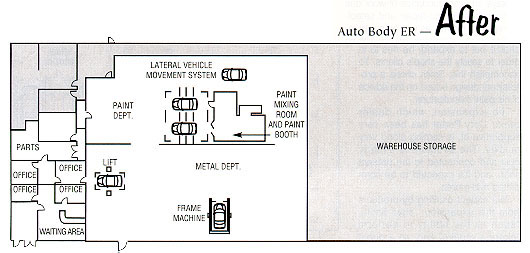
As a result, Hanson had them reconfigure the design three or four
different ways. "I’m a little embarrassed to admit that I
ultimately chose their original plan," he says. "In
retrospect, I should have realized that, as experts in layout
design, they would have considered all of the options before they
submitted the first plan. When you utilize experts, you need to
take advantage of their expertise."
The final design has worked very well for Auto Body, E.R. The
original reception area and offices were remodeled into a customer
waiting area with a customer restroom, a counter/workstation for
a customer-service representative and an office for the shop manager,
with an extra office for insurance adjusters to use; the office
area has a total of 955 square feet. The locker rooms were then
converted to a parts room (265 square feet), an employee lunch
room and an employee restroom.
As customers are waiting for an estimate or delivery, they can
view the shop from the reception area through a large window.
The customer-service representative is strategically positioned
behind the front counter, and the manager has a separate office
for preparing and selling estimates.
In the production area, all remnants of the fitness club were
removed, including interior walls and racquetball courts – with
the exception of a center wall, which was left to divide the metal
and paint production areas. In addition, drainage was added to
accommodate a detail area, and firewalls had to be erected, which
left a remaining 10,000 square feet of production area (metal
getting 5,200 square feet and paint 4,800 – due to a hallway leading
to an emergency exit).
The layout plan of the facility anticipated the flow of production
and effectively provides 22 bays, 11 in the metal department and
11 in the paint department. Upon entering the shop, you’re in
the metal department. Vehicles move from the metal shop to the
paint shop through a garage door in the center wall and then back
to the metal shop for reassembly through another garage door.
The design correctly allows a wide lane for reassembling and moving
vehicles. In addition, the paint area strategically positions
the downdraft spraybooth with the air make-up unit on the roof
and utilizes the slightly irregular (wider) shape of the prep
area. "While we’re not at production capacity yet, it’s obvious
that the layout will maximize the capacity of this facility,"
says Hanson.
For Hanson – who splits his time 50/50 between the body shop and
his investment banking business – the single biggest frustration
was dealing with the independent contractors who were operating
on their time schedules, not Hanson’s: He wanted an April 1 opening;
he got a May 1 one.
When he remodels again, Hanson says he’ll prepare a time schedule
for activities and then have a production meeting with all the
contractors. After they agree to the schedule, he says he’ll implement
a monetary penalty, per day, for missing production deadlines.
"I believe that the potential loss of money is the most effective
way to focus a contractor’s attention," he says.
Learn Through Examples
Though all these layout and design ideas may not work for your
shop, they illustrate options and how different shop owners tackle
the same kinds of problems.
Because there’s no "one perfect layout" that’s going
to fix every shop’s production problems, take what applies to
you and leave what doesn’t. These shop owners solutions may not
solve your problems, but they may give you an idea about what
will.
Writer Eileen Benedict is associate editor of BodyShop Business.













